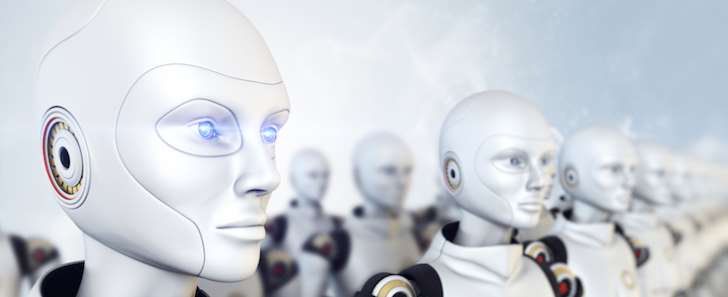(单词翻译:单击)
Artificial intelligence, which is the ability of machines to react intelligently to their environment, has been undergoing tremendous progress in the last decade. An AI program can mimic human functions such as problem solving and learning. While it's true that AI offers much promise for the development of smarter and more useful machines, it also fills many with fear of a dystopian future where millions are thrown out of work, replaced by robots and smart machines.
人工智能是机器对周遭环境作出智能反应的能力,过去10年来,人工智能已取得了巨大进展。一个人工智能程序能模仿人类的功能,例如:解决问题和学习。尽管,我们承认人工智能让我们更有希望,发展出更智能、更有用的机器,但很多人也会担心未来的世界是反乌托邦的:几百万人将会丢掉饭碗,被机器人和智能机器取代。
It's perhaps possible that humans will one day be reduced to servants of our machine overlords, but a sober appraisal predicts a mixed impact of AI on the job market. History teaches us that machines do displace humans, but somehow there are still plenty of jobs available today. The reason is that automation can substitute for labor on certain jobs, but also complements labor for other jobs that are not easily automated, making labor more productive and actually increasing the demand for workers.
也许有一天,人类会沦落为机器霸主的仆人,但更为清醒的评估则预测出了人工智能对就业市场的混合影响。历史教会我们:机器是会取代我们的,但现今在某种程度上,我们还是有很多的工作选择。原因是:自动化可以替代某些工作,但也为其它不那么容易自动化的工作补充了劳动力,这样就会更加多产,实则也会增加对工人的需求。
Jobs that are composed of repetitive tasks are the ones most vulnerable to automation. Examples including automated weaving machines, ATMs, production-line welders and phone answering systems. It might seem that these advances would simply throw people out of work. But look at the example of the weaving machines. They increased productivity 50-fold and dropped the price of cloth by 98 percent. The demand for cloth exploded as the price fell, thereby creating more weaver jobs. In the years between 1830 and 1900, the number of weaver jobs increased 4-fold despite automation. Automation increased demand for weavers, but also changed the nature of the weaver's job. A similar process happened with ATMs, which did not remove the need for human tellers, whose numbers actually have risen since ATMs were introduced in the 1970s.
那些不断重复做任务的工作是最容易被自动化的。例如:自动编织机、自动取款机、生产线焊工和电话应答系统。看起来,这些进步会让人们丢了工作。但让我们以编织机为例,看看情况。编织机使生产率提高了50倍,衣服的价格也相应下降了98%。随着价格下滑,人们对衣服的需求量爆增,因此就创造出更多的编织工作。在1830-1900年间,尽管工厂实行了自动化,纺织工作却翻了两番。自动化增加了对织工的需求,但也改变了织工的工作性质。自动取款机也遇到了相似状况,自动取款机的出现并没有减少人们对出纳员的需求,实际上,自20世纪70年代引入取款机以来,出纳员人数有增无减。

The intelligent response is for the public and private sectors to create worker training programs to teach new skills that will be required despite the spread of automation. This will require an investment in on-the-job training and lifelong learning. Some experts point to the social policies adopted by Denmark that make hiring and firing easy, yet support out-of-work employees as they receive retraining and search for a new job.
尽管实施自动化的部门越来越多,智能响应却为公立和私营部门创造工人训练计划、教授他们必需的新技能。这就需要对在职培训和终身学习进行投资。有些专家指向了丹麦采取的政策,该政策使雇佣和解雇简单方便,但又对接受再训练和寻找新工作的失业人员表示支持。
译文属可可原创,仅供学习交流使用,未经许可请勿转载


